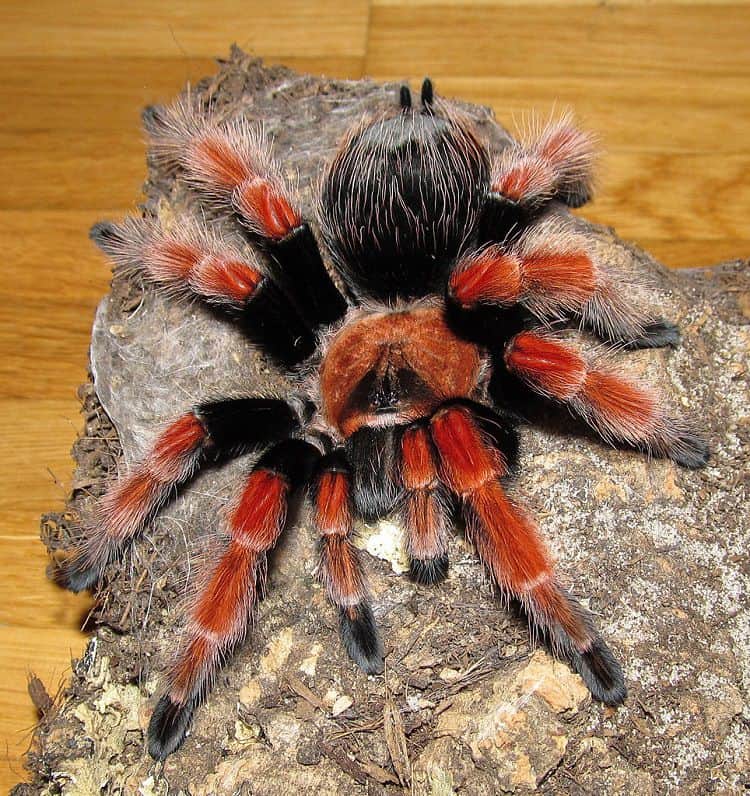Table of Contents
As with all living things, tarantulas need water to survive. However, in their natural habitat tarantulas tend to obtain most of the water they need from the food they eat rather than drinking from a water source (or any type of dish-like receptacle). In captivity though, things can be a little bit different.
Is a Water Dish Essential for Tarantulas?
If you have a tarantula at home, providing water for it is good practice. There are those who insist that this is not necessary and say that tarantulas get enough water from their food and possibly through misting. Others insist that providing water in a dish inside within the tarantulas’ enclosure is risky as it could result in drowning, especially if there are slings in the tank. This is not the case. The reality is that tarantulas can survive for a long time without oxygen and they can even float on water. Baby tarantulas are particularly adept at floating, so it is highly unlikely that any would drown in a water dish. What is more likely is that the tarantulas could die from dehydration with no access to a sufficient water source. Indeed, tarantulas can go quite some time without food, but not so when it comes to water.
at home, providing water for it is good practice. There are those who insist that this is not necessary and say that tarantulas get enough water from their food and possibly through misting. Others insist that providing water in a dish inside within the tarantulas’ enclosure is risky as it could result in drowning, especially if there are slings in the tank. This is not the case. The reality is that tarantulas can survive for a long time without oxygen and they can even float on water. Baby tarantulas are particularly adept at floating, so it is highly unlikely that any would drown in a water dish. What is more likely is that the tarantulas could die from dehydration with no access to a sufficient water source. Indeed, tarantulas can go quite some time without food, but not so when it comes to water.

Acanthoscurria gomesiana 
Blue Foot Baboon 
Brazilian Red Birdeater
Mimicking a Tarantula’s Natural Habitat
As mentioned above, tarantulas do not have water dishes in the wild, but neither do any other species. What they do have is access to water from other sources. There are those who will argue that most tarantulas come from hot, dry areas so would not have access to water, but the reality is that even the most arid places in the world will get rain at times. And don’t forget that when it comes to the tarantulas that hail from tropical parts of the world, rain is commonplace.
At the end of the day, owning a tarantula means that it is your responsibility to ensure conditions are as ideal as they can possibly be. You do not, though, have to mimic the tarantula’s natural habitat to the point where you are making it difficult for it to access water. Knowing that a tarantula requires water to survive, and knowing that by placing a water dish in the enclosure will not harm it but will instead ensure that it can access water as and when it needs, is reason enough to have one.

Trinidad Dwarf Tarantula 
Chaco Golden Knee 
Acanthoscurria theraphosoides
In addition to providing a water source for your tarantula, a water dish can offer other benefits as well. For example, having a water dish in the enclosure helps with humidity. Although misting an enclosure is a terrific way to provide humid conditions, the reality is that the benefit of misting for tarantulas does not last for very long. And with many keepers only misting a couple of times per week, a water dish in the tank will ensure ideal conditions for longer.
Photo Credits:
- Featured Image (Mexican Fireleg): Micha L. Rieser

- Acanthoscurria gomesiana: Source: Hector M. O. Gonzalez-Filho, Sylvia M. Lucas, Felipe dos S. Paula, Rafael P. Indicatti, and Antonio D. Brescovit (2012) “On the Taxonomy of Acanthoscurria Ausserer from Southeastern Brazil with Data on the Natural History of A. gomesiana Mello-Leitão (Araneae, Mygalomorphae, Theraphosidae)”, International Journal of Zoology, vol. 2012. doi
 :10.1155/2012/721793
:10.1155/2012/721793 Figure 1
Figure 1 – This file is licensed under the Creative Commons
– This file is licensed under the Creative Commons Attribution 3.0 Unported
Attribution 3.0 Unported license.
license. - Blue Foot Baboon: Quengsalinas – This file is licensed under the Creative Commons
 Attribution-Share Alike 4.0 International
Attribution-Share Alike 4.0 International license.
license. - Brazilian Red Birdeater: Hectonichus
 – This file is licensed under the Creative Commons
– This file is licensed under the Creative Commons Attribution-Share Alike 3.0 Unported
Attribution-Share Alike 3.0 Unported license.
license. - Trinidad Dwarf Tarantula: Morkelsker – public domain
- Chaco Golden Knee: PavelSI – public domain
- Acanthoscurria theraphosoides: Sjl197 – This file is licensed under the Creative Commons
 Attribution-Share Alike 4.0 International
Attribution-Share Alike 4.0 International license.
license.

